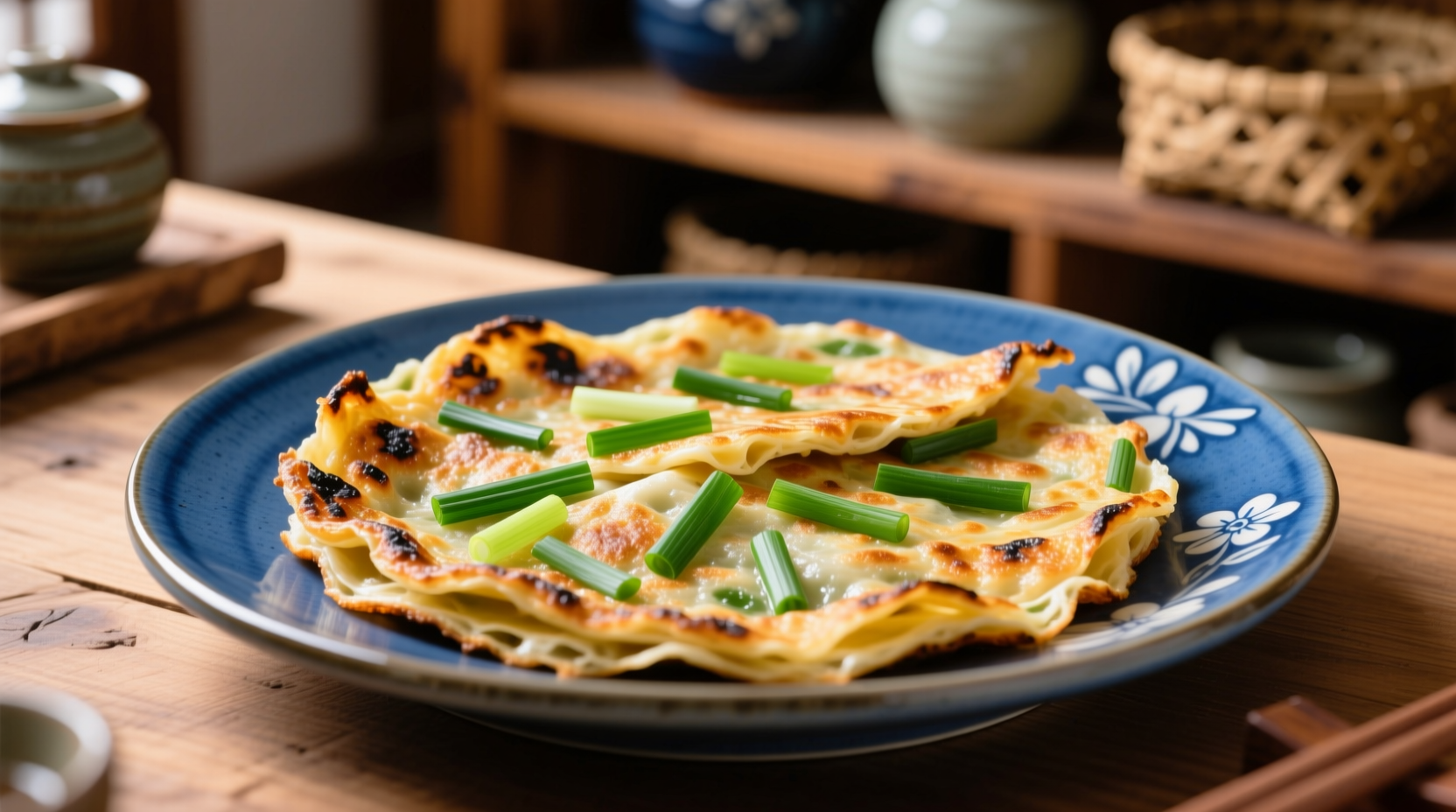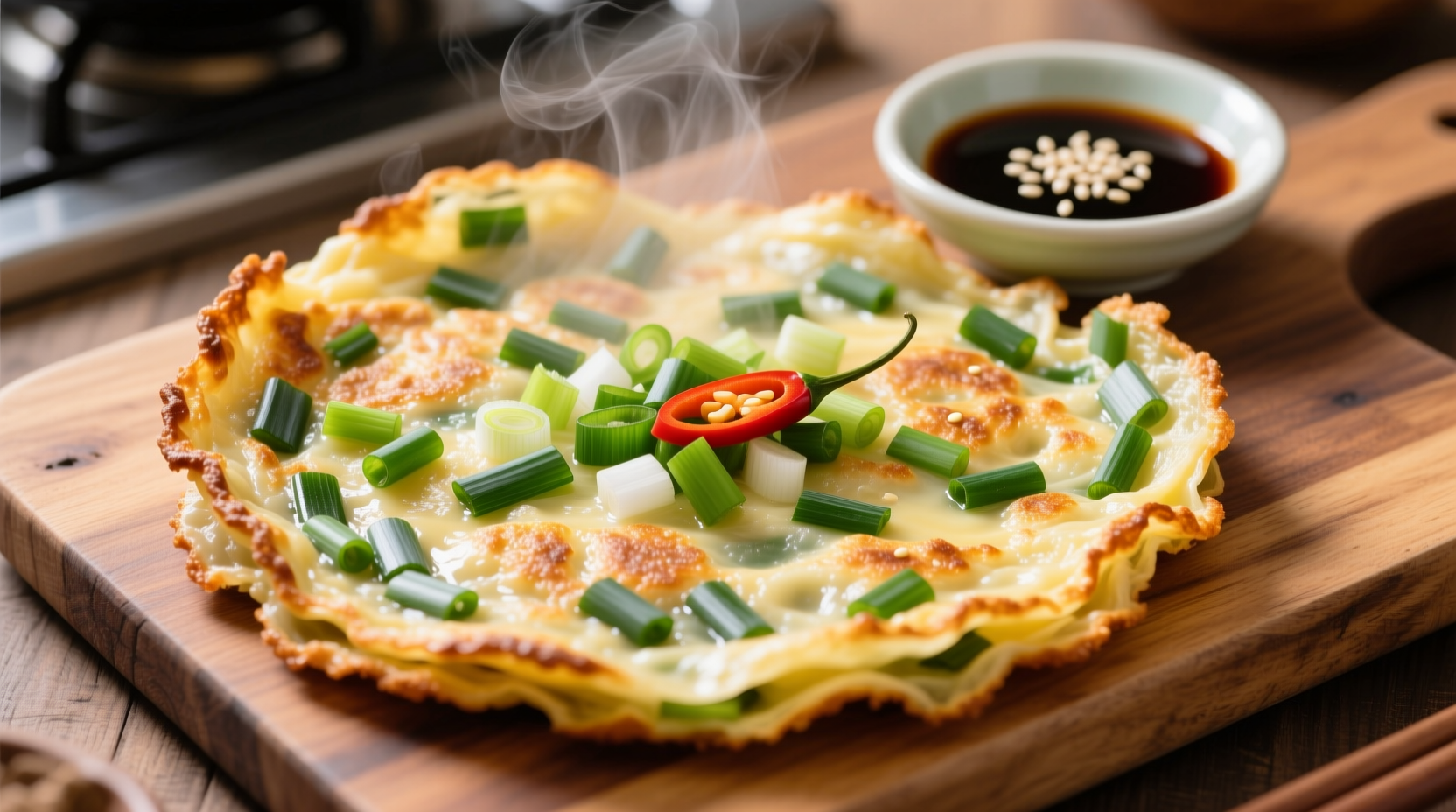The Essential Guide to Perfect Korean Green Onion Pancakes
Master the art of making authentic pajeon with this comprehensive guide. You'll learn not just the recipe, but the cultural significance, precise techniques, and common pitfalls to avoid for restaurant-quality results at home. Whether you're a beginner or looking to refine your skills, this guide delivers everything needed to create crispy, flavorful Korean pancakes that impress.
What Makes Pajeon Special: More Than Just a Pancake
Pajeon isn't merely food—it's a cultural experience deeply woven into Korean traditions. Unlike Western pancakes, pajeon features a delicate balance of textures: crispy edges with a tender interior, loaded with fresh green onions that provide both flavor and visual appeal. The dish dates back to Korea's Joseon Dynasty (1392-1910), originally prepared as temple food before becoming a beloved street food and home-cooked meal.
| Historical Period | Pajeon Evolution | Cultural Significance |
|---|---|---|
| Joseon Dynasty | Simple wheat flour and green onion preparation | Served as temple food for Buddhist monks |
| Japanese Occupation (1910-1945) | Seafood additions became common | Symbol of resilience using available ingredients |
| Modern Era | Regional variations emerged nationwide | Designated as intangible cultural heritage in 2013 |
According to the Korean Cultural Heritage Administration, pajeon was officially recognized as part of Korea's intangible cultural heritage in 2013, highlighting its importance beyond mere sustenance. The dish represents Korean culinary philosophy of "bap-sang-illyo" (rice, soup, side dish, and kimchi), where pajeon often serves as the special side dish for celebrations.
Authentic Ingredients: The Foundation of Flavor
The magic of pajeon lies in its simplicity—few ingredients executed perfectly. For the most authentic Korean green onion pancake recipe, you need:
- Green onions: 300g (about 15-20 large), white and green parts separated
- All-purpose flour: 1 cup (120g)
- Rice flour: ½ cup (60g) - crucial for crispiness
- Eggs: 2 large, beaten
- Water: 1 cup (240ml), ice-cold
- Salt: ½ teaspoon
- Sesame oil: 1 tablespoon (for cooking)
The precise flour ratio matters significantly. Research from the Korean Food Foundation confirms that the 2:1 wheat-to-rice flour ratio creates the ideal texture—wheat flour provides structure while rice flour delivers the signature crispness without becoming greasy. Many home cooks make the mistake of using only wheat flour, resulting in a dense, chewy pancake rather than the desired light, crispy texture.

Step-by-Step Preparation: From Batter to Perfect Flip
Follow these professional techniques to achieve restaurant-quality pajeon at home:
Batter Preparation Secrets
Mix dry ingredients first—combine flours and salt in a large bowl. Whisk eggs with cold water separately before gradually incorporating into dry ingredients. The key is not to overmix; lumps are acceptable and actually prevent gluten development that would make your Korean pancake green onion tough. Let the batter rest for 15 minutes—this allows the flours to fully hydrate and creates a more stable structure.
Green Onion Preparation
Cut white parts into 2-inch segments and green parts into 1-inch segments. The white parts need more cooking time, so adding them first ensures even doneness. For authentic Korean scallion pancake texture, arrange green onions in a single layer before pouring batter over them—this creates that beautiful, signature green onion top layer.
Cooking Technique Mastery
Heat a non-stick skillet over medium-high heat with sesame oil. Pour batter to create a thin, even layer (about ¼ inch thick). The critical temperature range is 350-375°F (175-190°C)—too hot and it burns before cooking through, too cool and it absorbs excess oil. After 3-4 minutes, when edges are golden and set, flip using a large spatula in one confident motion. Cook another 2-3 minutes until both sides are golden brown.
Avoiding Common Pajeon Pitfalls
Even experienced cooks make these mistakes when attempting Korean pancake green onion recipes:
- Overmixing the batter: Creates tough pancakes due to gluten development
- Incorrect oil temperature: Below 350°F leads to greasy pancakes; above 375°F causes burning
- Overcrowding the pan: Prevents proper crisping and creates steamed rather than fried texture
- Flipping too early: Wait until edges are set and bubbles form on surface
- Using old green onions: Fresh, firm green onions with vibrant color are essential
The Perfect Dipping Sauce: More Than Just Soy Sauce
Authentic pajeon dipping sauce balances salty, sour, and spicy elements. Combine:
- 3 tablespoons soy sauce
- 1 tablespoon rice vinegar
- 1 teaspoon sugar
- ½ teaspoon gochugaru (Korean red pepper flakes)
- 1 minced garlic clove
- 1 teaspoon toasted sesame seeds
Mix ingredients and let sit for 15 minutes before serving to allow flavors to meld. The vinegar cuts through the richness while the gochugaru adds subtle heat without overwhelming the delicate pancake. This traditional Korean pancake green onion accompaniment enhances rather than masks the main dish's flavor.
When and How to Serve Pajeon
In Korea, pajeon is traditionally enjoyed during rainy days—hence the nickname "cheonil shiksa" (rainy day food). The sound of rain matches the sizzling of the pancake in the pan, creating a multisensory experience. Serve immediately after cooking while still hot and crispy.
Pair with makgeolli (Korean rice wine) for the classic combination, or with a light lager beer. For a complete Korean street food green onion pancake experience, serve alongside kimchi and japchae (stir-fried glass noodles).
Regional Variations Across Korea
While the basic Korean green onion pancake recipe remains consistent, regional variations showcase Korea's culinary diversity:
- Busan: Haemul pajeon (seafood pancake) with abundant squid and shrimp
- Jeonju: Bibimbap-style pajeon with mixed vegetables
- Seoul: Traditional pajeon with minimal additions focusing on green onion flavor
- Gyeongsang Province: Kimchi pajeon with aged kimchi for tangy flavor
These variations reflect local ingredients and preferences, demonstrating how Korean pancake green onion recipes adapt to regional tastes while maintaining the core preparation method.
Storage and Reheating: Maintaining Crispiness
While pajeon is best enjoyed fresh, leftovers can be stored properly. Cool completely, then place parchment paper between layers in an airtight container. Refrigerate for up to 2 days.
For reheating, avoid the microwave which creates sogginess. Instead, use these methods:
- Air fryer: 350°F for 3-4 minutes until crispy
- Oven: 375°F on a wire rack for 5-7 minutes
- Skillet: Medium heat with minimal oil for 2-3 minutes per side
Freezing is not recommended as the high moisture content from green onions affects texture upon thawing.
Mastering Korean Pancake Green Onion at Home
Creating authentic pajeon requires attention to detail but rewards with impressive results. Focus on fresh ingredients, proper batter consistency, and precise cooking temperature. Remember that the best Korean green onion pancake recipe balances simplicity with technique—few ingredients executed perfectly create extraordinary flavor.
Whether you're exploring Korean street food green onion pancake traditions or seeking an easy homemade pajeon recipe for a rainy day, this guide provides everything needed for success. The key is respecting the dish's cultural heritage while adapting techniques to your home kitchen.











 浙公网安备
33010002000092号
浙公网安备
33010002000092号 浙B2-20120091-4
浙B2-20120091-4